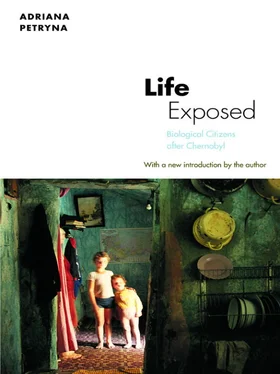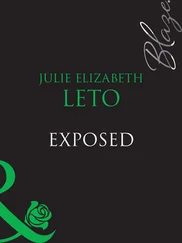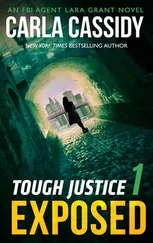Chernobyl was a watershed event marking communism’s end, defining critical tensions in international relations, accelerating processes of glasnost, and giving glasnost exceptional relevance in Ukraine. The disaster generated consequences, many of which are yet to be grasped, and whose truths have been only partly revealed through estimates derived from experimental science. If, at the level of the modern state, spheres of scientific production and politics are in a constant process of exchange and mutual stabilization, then here stabilization proves to be a much more difficult task. That is because reality can subvert scientific claims to certainty and truth. As Ulrich Beck notes, in the flood of contradictory findings that is so characteristic of large-scale industrial disasters, scientific reason can break up into many sets of competing rationalities “with specific claims to errors, deceptions, and truths” (1992:167). Such uncertainty in scientific spheres can produce a social and political unraveling. In the Ukrainian context, the unraveling has taken the form of an expanding set of claims based on Chernobyl-related damages. Such claims reflect new experimental fabrics in which science, nation building, and market developments are interdependent, and where the biology of citizens becomes a contested part of a political process and a tool of government.
FIGURE 1. Map of Ukraine
Ukraine is located between Poland to the west and Russia to the east, both of which (in addition to the Austro-Hungarian and Ottoman Empires) have laid claim to Ukrainian territories over the past three centuries (figure 1). At the time of the disaster, Ukraine was the second largest of fourteen republics of the Soviet Union, with a population of approximately fifty million. [25] The country’s current population growth rate is -0.83 percent. The population numbers 49,153,027.
Once known as the breadbasket of the Soviet Union, the country is also a land of pogroms and wars. Many Ukrainians today regard the region as having been a brutal laboratory for Stalinist collectivization campaigns and the site of a state-induced famine of 1932–1933 in which, according to one estimate, six million people are said to have died. [26] This figure is based on an estimation made by historian Robert Conquest in his important but contested contribution to the history of the famine. See Conquest 1986.
Many immigrants know it as a place from which their Jewish ancestors, survivors of pogroms, fled in the late nineteenth and early twentieth centuries. During World War II, German and Soviet armies clashed in Ukraine’s villages and cities, leaving behind ruins as well as new social spaces for the mobilization of public support for the socialist order, as evidenced by rapid and massive postwar reconstruction efforts. In the late sixties, Chernobyl was built as a kind of reactor theme park to show the world how advanced and well-organized Ukrainian socialist society and life had become.
Like other nascent post-Soviet states, Ukraine became sovereign and democratic without much prior experience. In the last century, Ukraine achieved sovereignty for a brief period in 1918, before Bolsheviks took over the capital. [27] Historians might argue that Pavlo Skoropadsky’s government was also at least semisovereign, as was Symon Petliura’s.
One of the leaders of that failed attempt declared: “Truly, we were like the gods…. attempting to create a whole new world from nothing” (Vynnychenko 1920:258, quoted in Subtelny 1988:354). Interestingly, national identity in Ukraine is, in part, an effect of a Stalinist policy called korenizatsiia (rooting). Korenizatsiia created nationalities that were fundamental to a kind of ethnoterritorial administration of socialist republics (Slezkine 1994). The motto of this policy was “National in Form, Socialist in Content.” Yet when the Ukrainians, Uzbeks, and Estonians among others emerged from their ethnoterritories, they did so at a time when prospects for building strong nation-states were faint. Ukraine was trapped in a paradox of having to constitute itself at the same time nation-states were increasingly becoming destabilized by globalizing forces. Although ethnically mixed, the country’s metamorphosis from a Soviet republic to an independent nation occurred without armed conflict—Ukraine never became the ethnic tinderbox that some American observers predicted it would be. These predictions were based on assumptions about ethnicity as the decisive marker of national belonging and therefore of possible internal conflict or war. What these observers failed to recognize was that their imaginary ethnic types were not at all predisposed to war. Instead they were asserting values related to life, values that were expressed not in spite of but because of a Soviet experience. [28] Main ethnic groups as registered by the country’s Ministry of Statistics include Ukrainians, Russians, Jews, and Armenians. Ukraine was the first country in the world to give up its nuclear arsenal. Rights of citizenship, religious expression, and speech were granted to all inhabitants, regardless of ethnic and religious affiliation. Police violence toward immigrant populations (particularly toward Africans and Muslims) in Kyiv was commonly reported in 1996.
Neither do the processes leading to Ukraine’s independence support a triumphal narrative in which a victimized Ukrainian nation subverts its colonizing master (Torbakov 2001:462). Soviet welfare legacies played an important role in shaping the way in which support for independence was won. At the time of independence, about 40 percent of all inhabitants of the Ukrainian republic were receiving one or more cash benefits. Legislators knew that in order to justify statehood and to win over citizens, they had to appeal to these inhabitants’ materialist side. They had to promise enhancements to a Soviet-style welfare state, including health and welfare benefits, in addition to guaranteeing civic freedoms, human rights, and equal participation in political life—what are generally regarded as the principles of a “classical citizenship” (Schnapper 1997:201). Soviet welfare legacies, as well as the dire economic conditions in which Ukraine declared independence, created a context for division and competition among groups for social welfare. [29] Indeed, public social spending nearly doubled from 1990 to 1991, jumping from 25 percent to 44.1 percent of the gross domestic product.
Thus the struggle for claims rights went hand in hand with a more universally bestowed civic logic of citizenship (202). [30] According to Schnapper (1997), claims rights define the rights of citizens “to receive services from the state: the right to a job, material well-being, education, time off, etc.” In contrast to liberty rights, “these rights imply state intervention to benefit the individual” (202). For an excellent review of Soviet concepts of citizenship, see “Nationality in Soviet and Post-Soviet Ukraine,” in Wanner 1998.
In 1991, the year Ukraine declared independence from the Soviet Union, leaders of this once socialist republic condemned the Soviet administration of the Chernobyl aftermath and began fostering their own political legitimacy. Nationalists, Communists, and Democrats alike entered into a novel (and short-lived) political alliance when they unanimously denounced the Soviet administration as an “act of genocide.” The charge of genocide referenced a national symbol of Soviet oppression, the 1930s famine, often described as man-made. [31] The First Five-Year Plan called for a total collectivization of individual peasant farms in Ukraine as well as in Kazakhstan and parts of Russia. All grain produced by peasants was collected and sold to finance industrialization. Those who resisted such collections by hiding grain met certain death, often by gunshot. As Wanner points out, “Famine conditions were produced more by the regime’s inflated demands for grain and seed than by the size of the harvest in any particular year” (1998:43). See Krawchenko 1985 and Subtelny 1994 for a detailed description of events that led to the famine. The famine affected all citizens of Ukraine, urban and rural, ethnic Ukrainian, Russian, and Jewish.
Legislators claimed that not only had the Soviet state apparatus failed in its obligation to protect citizens’ lives during Chernobyl but that in its denial of the event and its effort to restart the nuclear program, it had exacerbated patterns of morbidity by delaying intervention.
Читать дальше












